Author: Marshall Schott
The first question on the Danstar Yeast F.A.Q. page has to do with an issue that seems to have garnered a fair amount of healthy debate in the homebrewing community over the years– whether one should rehydrate dry yeast before pitching or simply sprinkle it on top of the wort. The recommendation provided by Danstar echoes much of what we’ve all heard from well known forces in the homebrew world:
Dry beer yeast needs to be reconstituted in a gentle way. During rehydration the cell membrane goes through changes which can be lethal to yeast. In order to reconstitute the yeast as gently as possible (and minimize/avoid any damage) yeast producers developed specific rehydration procedures. Although most dry beer yeast will work if pitched directly into wort, it is recommended to follow the rehydration instructions to insure the optimum performance of the yeast.
So basically, sprinkling dry yeast directly on the wort may work, but rehydration provides some insurance the yeast performs optimally. Some studies have demonstrated yeast viability is reduced by upwards of 50% when sprinkled on wort as compared to being rehydrated prior to pitching, which is meaningful for homebrewers who often rely on fairly specific estimates of pitching rates. What, if any, differences would there be between the same wort split then pitched with rehydrated yeast versus sprinkled with dry yeast?
| PURPOSE |
To investigate the differences between dry yeast sprinkled directly on the wort and pitching rehydrated yeast.
| METHOD |
I’d been interested in making a more traditional German style lager beer with Nottingham yeast fermented cool and thought Munich Dunkel seemed like a good fit. An 11 gallon batch of wort was produced and split between 2 fermentors.
OG: 1.050
FG: 1.013
ABV: 4.9%
IBU: 21
SRM: 16
13 lbs Gambrinus Munich 10L
5.5 lbs German Pils Malt
8.0 oz Carafa Special II
4.0 oz Melanoidin Malt
~15 IBU Hallertauer Mittelfrüh @ FWH
28.0 g Hallertauer Mittelfrüh @ 20 min
28.0 g Hallertauer Mittelfrüh @ 5 min
Danstar Nottingham Ale Yeast
Mash at 154°F for 60 minutes
Chill to 58°F pitching temp, ferment at 60°F
This was one of those spur of the moment brew days that thankfully went off without a hitch. Toward the end of my 1 hour mash, just before running off the first portion of sweet wort, I threw the FWH charge of Mittelfrüh hops into the kettle. First wort hopping is a method I’ve been messing around with for a bit, I’m still torn as to the character it imparts as compared to more traditional bittering additions and have an exBEERiment planned to test it out.
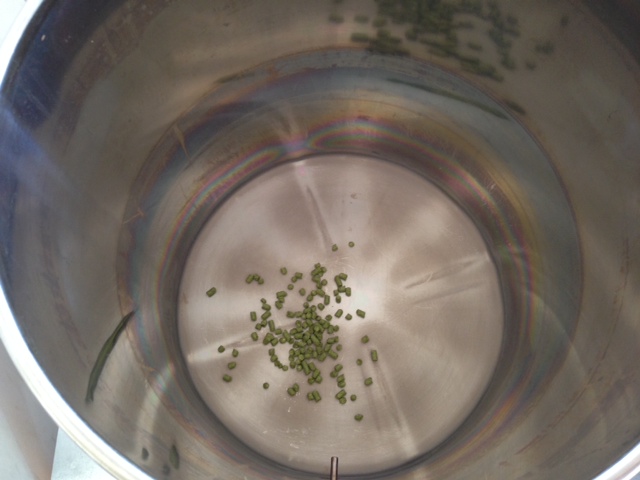
The wort was boiled and chilled very quickly to 6°F above groundwater temp using my new Hydra IC from JaDeD Brewing (review coming soon).
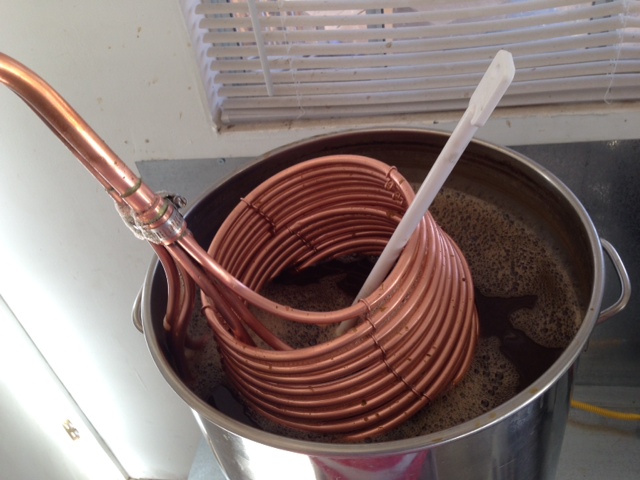
I hit my target OG spot on according to both my hydrometer and refractometer.
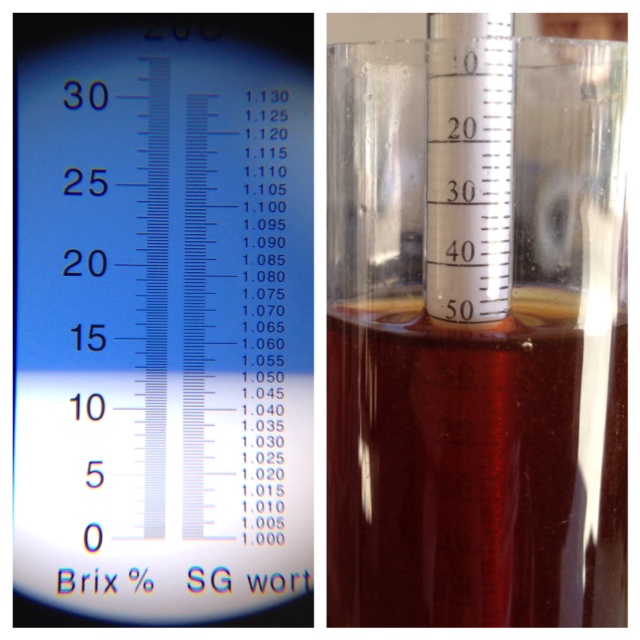
Each carboy of wort was placed in my cool fermentation chamber to finish cooling, typical practice for me during the warmer months when I can’t chill to pitching temps. It took about 4 hours for the wort to drop to 58°F. Before pitching, I rehydrated 1 sachet of yeast in 93.5°F water for 15 minutes then placed that slurry into the fermentation chamber until it dropped to within 10°F of the wort temp, this took about 20 minutes with regular swirling of the jar.

The rehydrated yeast was poured into one carboy while another sachet of Nottingham (same expiry date) was sprinkled directly into the other carboy. After about 12 hours, the dry pitch batch had what appeared to be a ring of small dry yeast globs and the rehydrated batch had some bubbles around the edge.
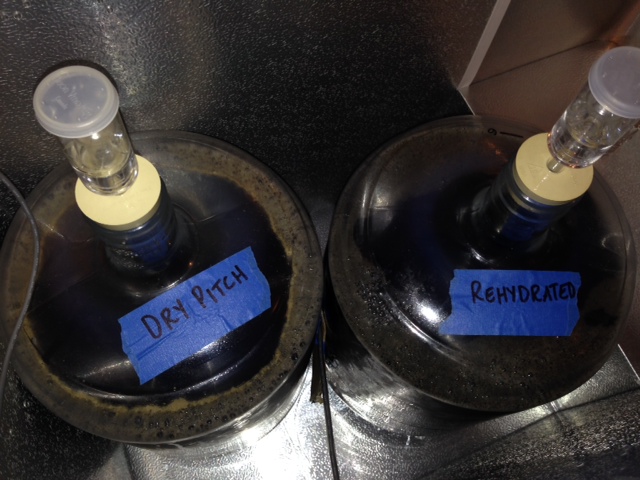
The only visible sign of fermentation at this point was the activity in the airlock, both burping about once every 10 seconds or so.
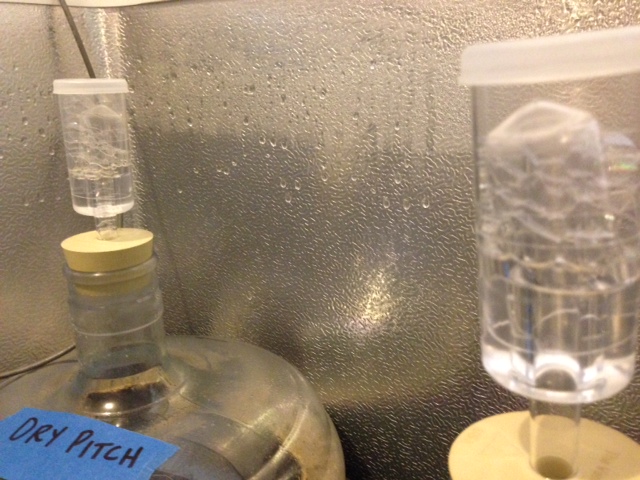
The beers were looking very similar at 20, 36, and 60 hours post-pitch.
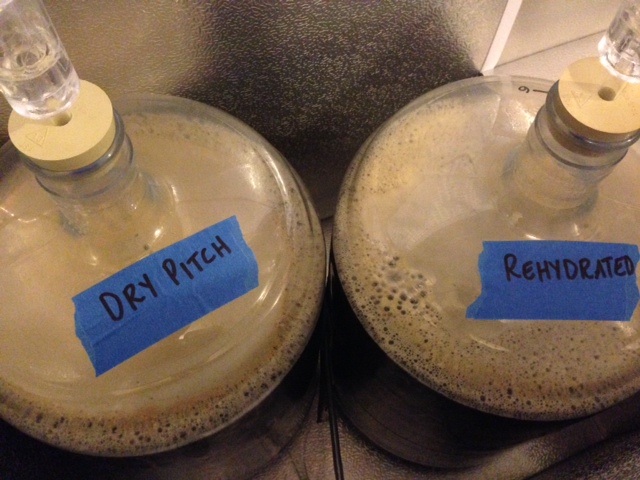
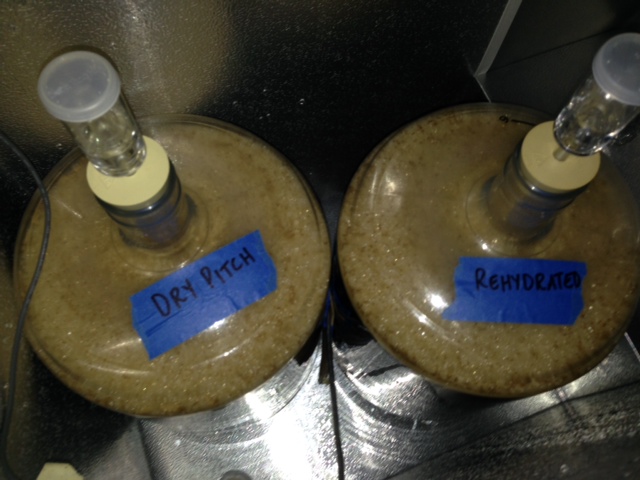
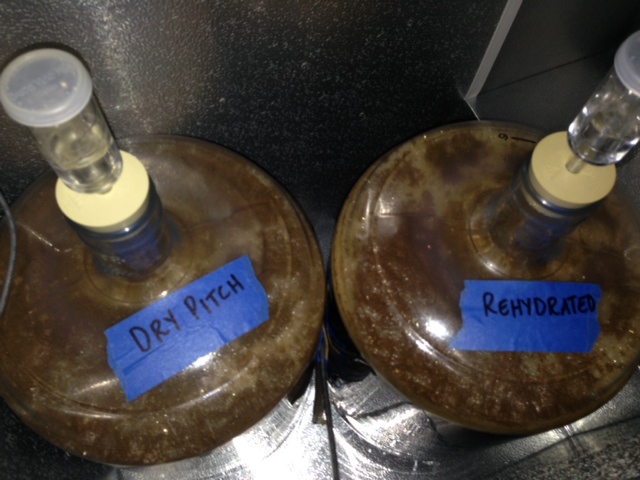
On day 4, fermentation activity had slowed significantly and the krausen on the dry pitch batch fell before the rehydrated batch.
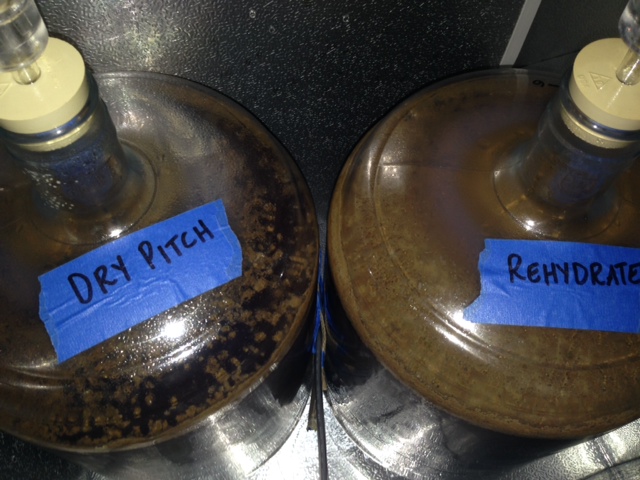
Twelve hours later and all was looking the same again.
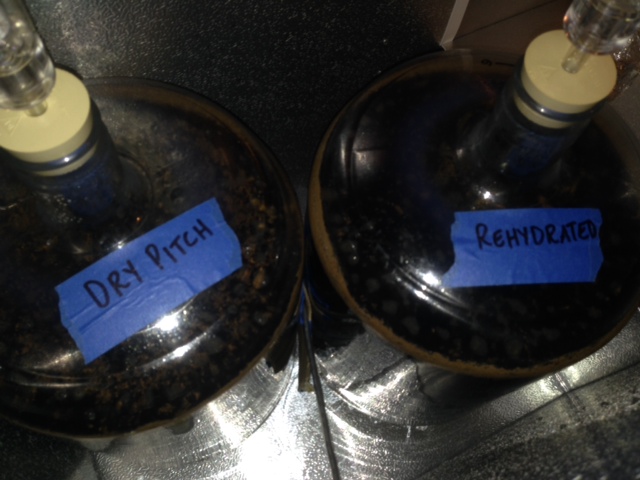
The temperature was ramped automatically per my hybrid fermentation profile on The Black Box controller. I took an initial gravity reading after a week in the fermentors.
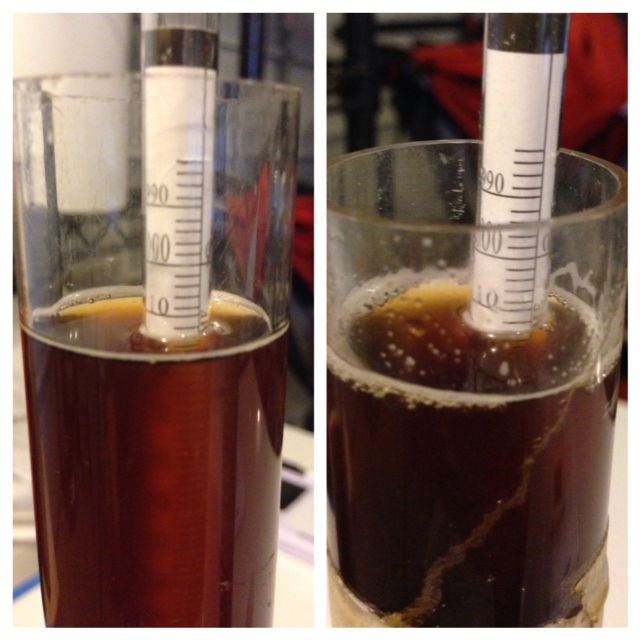
My target FG was reached and remained at 1.013 in subsequent readings. After a gradual 4 day cold crash, it was time for packaging- again, no significant differences were observed at this point.
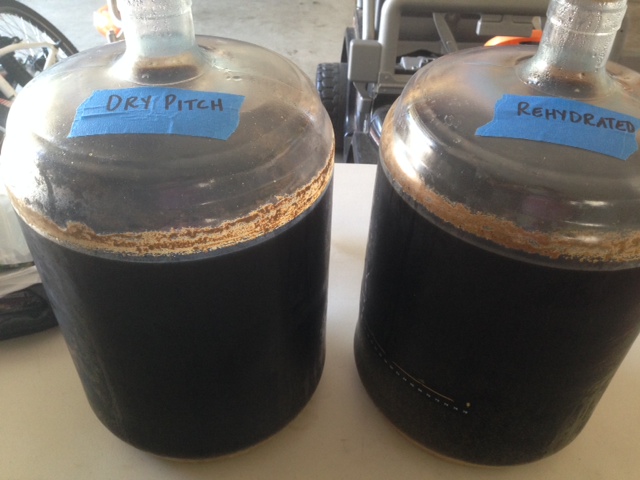
I kegged and carbonated the beers as usual then they hung-out in my keezer for 2 weeks before they were evaluated.
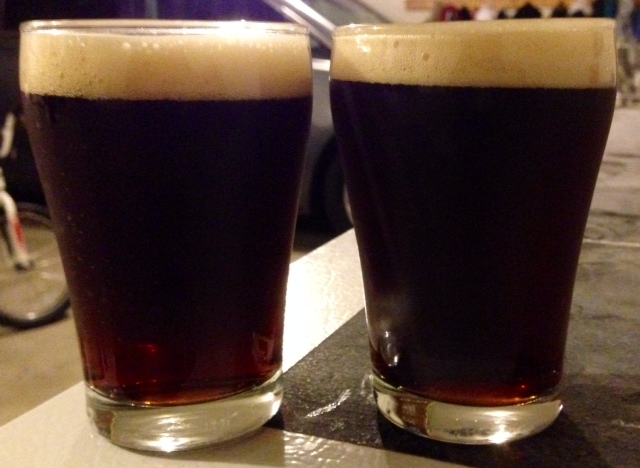
Boring but important: I reworked the data collection procedure for this exBEERiment in hopes of providing more meaningful results in a less cumbersome fashion. Rather than asking all participants to provide feedback on 2 beers they taste blind, I instead had them complete a discrimination sensory evaluation known as a triangle test. Here’s how it worked:
Step 1: A piece of paper with a 3 shapes (triangle, square, star) was placed on a table.
Step 2: A clear plastic cup was placed on each shape.
Step 3: Prior to the participant entering the room, the dry pitch beer was added to 2 cups (square, star) and the rehydrated beer was added to 1 cup (triangle).
Step 4: Participants were then asked to enter the room and complete a brief online survey that asked them to consider which of the beers was different then choose 1 of 4 options: triangle, square, star, or no detectable difference.
Step 5: Once the participant submitted their response, they informed me (privately) what they chose– those who were incorrect were dismissed and those who were correct were asked to complete a more detailed survey comparing the differences between only the 2 different beers while still blind to nature of the exBEERiment. At this point, the rehydrated beer was relabeled “Sample A” and the dry pitch beer became “Sample B.” While still not up to snuff for some of the more scientific folks, this setup worked much better than I anticipated, I definitely plan to continue using it in the future. If you have any suggestions, please feel free to share them. Now, onto the interesting stuff!
| RESULTS |
In all, 13 people participated in the sensory evaluation portion of this exBEERiment with only 5 accurately selecting the triangle as being the different beer. A single participant detected no differences while 4 experienced star as being different and the other 3 chose square. In sum, less than 40% of the participants, all of whom are experienced homebrewers and craft beer enthusiasts, were capable of discriminating a beer fermented with rehydrated yeast from one sprinkled with dry yeast.
Of the 5 participants who did accurately choose the different beer, the large majority went on to report essentially no difference between the dry pitch and rehydrated samples in terms of appearance.
Aromatically, 3 of the survey takers experienced the rehydrated beer as being more malty and the dry pitch beer as being more hoppy. Two participants perceived the rehydrated beer as having a stronger ester/phenol character, 1 selected the dry pitch and another detected no differences. Everyone described the aroma between the 2 beers as being only somewhat similar, with 3 preferring the dry pitch and 2 preferring the rehydrated beer.
In terms of malt flavor, 2 participants perceived the rehydrated beer as being more malty, 2 thought it was the dry pitch beer, and only 1 detected no differences. These results were the same when asked about hop flavor. Three people selected the rehydrated beer as having the better fermentation/yeast character and, again, only 1 detected no differences. The dry pitch beer was selected by 2 people as having more off-flavors while 2 people detected no differences. Four participants thought the flavor of the beers were somewhat similar and one experienced them as not at all similar. When asked which beer had the better overall flavor, 3 selected the dry pitch beer and 2 selected the rehydrated beer.
The majority of participants (3) selected the dry pitch beer as having better overall mouthfeel with only 1 preferring the rehydrated beer and 1 detecting no differences.
Three of the survey takers reported a general preference for the beer fermented with dry yeast sprinkled on the wort while the other 2 preferred the beer pitched with rehydrated dry yeast.
At the end of the survey, the 5 participants were informed of the nature of the exBEERiment then asked to select which beer they believed was fermented with rehydrated yeast. Three of the 5 people accurately selected Sample A.
| DISCUSSION |
I went into this exBEERiment from a place of ambivalence, not just because I’ve rarely used dry yeast, but in my experience both approaches to pitching have yielded at least moderately enjoyable beer. Based almost solely on information gleaned from homebrew podcasts, books, and blogs, I’d say my personal bias was skewed slightly toward the rehydrated beer as being the better of the 2. In fact, I’ve made rehydration of dry yeast a normal part of my routine over the last year as a result of this information. I had both beers served to me “blindly” multiple times and was consistently able to accurately determine which beer was which. Like some of the participants who made it past the triangle test, I perceived the rehydrated beer as being noticeably more malty and smoother than the dry pitch beer, which had what I can only describe as a subtle apple-like tartness, perhaps as a result of acetaldehyde from stressed yeast(?). I didn’t notice any differences at all in appearance or mouthfeel and neither have any real significant flaws that I could pick up.
Will I continue to rehydrate dry yeast before pitching? Yeah, I think so, despite the fact less than half of the experienced beer drinkers (BJCP judges and Cicerone beer servers included) who participated in the triangle test were unable to accurately choose the beer that was different. Do I think sprinkling dry yeast directly onto wort is poor practice? Not anymore! Some people even seem to prefer whatever character they detected from the beer fermented in this manner. I do believe, though, that with higher OG comes increased risk of yeast off-flavor and that the insurance provided by rehydration may be of benefit. Or maybe not, who knows… I smell another exBEERiment in the works!
In case you’re wondering…
Nottingham fermented at 60°F produced a pretty damn crisp Munich Dunkel with no perceptible ale-like esters you might expect from a British yeast. While the beer is good, it is missing some of that lager character I get from other strains fermented cool, particularly WLP029. I do think there are certain styles that may lend themselves to this yeast a bit more than others, maybe a rich Doppelbock or a malty Baltic Porter. For the lighter lower OG styles, I’ll stick with my go-to, WLP029.
If you have any questions or comments, please don’t hesitate to leave them below. Cheers!
Support Brülosophy In Style!
All designs are available in various colors and sizes on Amazon!
Follow Brülosophy on:
FACEBOOK | TWITTER | INSTAGRAM
| Read More |
18 Ideas to Help Simplify Your Brew Day
7 Considerations for Making Better Homebrew
List of completed exBEERiments
How-to: Harvest yeast from starters
How-to: Make a lager in less than a month
| Good Deals |
Brand New 5 gallon ball lock kegs discounted to $75 at Adventures in Homebrewing
ThermoWorks Super-Fast Pocket Thermometer On Sale for $19 – $10 discount
Sale and Clearance Items at MoreBeer.com
If you enjoy this stuff and feel compelled to support Brulosophy.com, please check out the Support Us page for details on how you can very easily do so. Thanks!











31 thoughts on “exBEERiment | Sprinkled vs. Rehydrated Dry Yeast In A Munich Dunkel”
Awesome write up. I’ve always been in the camp of pitching dry but might move to rehydrating to see to test for myself.
Very nice! What’s the consensus for using starters with dry yeast? Unnecessary?
Thanks! I think the popular consensus is that starters are unnecessary for dry yeast… but I’ve yet to play around with this, so I’m not comfortable giving a personal opinion.
This same experiment was done over at Basic Brewing Radio and in at least one homebrew mag, and they all seem to give similar results. Which is exactly how science is supposed to work! Its always nice to see multiple sources with slightly different setups reporting essentially the same thing. At least with a reasonable gravity beer, I think we as brewers can finally not feel any shame in pitching the yeast dry, and avoid one potential time for infection to get into the beer.
– Dennis, Life Fermented Blog
I would like to see this experiment done on a high gravity beer. I believe then you will see some difference.
It’s on the list! I purposely did this first one on a more “normal” OG beer with plans to run it again on a higher OG beer later. Cheers!
And similarly the results could vary greatly from Lager to Ale. I suspect the higher ferm temperatures in ales exacerbate the differences.
What I find ironic, is that they recommend rehydrating the yeast on the website, the package states “Sprinkle on wort”
What’s your opinion on using a starter for the Wyeast “Direct Pitch Activator” packs? Necessary, nice to have, or don’t bother?
“Direct Pitch Activator” is marketing, those smack packs only come with about 100bil cells, the same as the White Labs vials. Starters are still definitely recommended.
Is the 100 billion cells figure before or after the yeasties mix with the wort inside the smack pack?
There is no wort in those smack packs, the capsule is just yeast nutrient. The 100bil cells is what’s in the pack the entire time, until you build it up in either a starter or your beer.
brulosopher, I mean this only constructively. I think appealing to cell count as the reason to make a starter with a smack pack while this exBEERiment had nothing to do with cell count but rather, had everything to do with quality of the final beer, is short sighted and probably worthy of an exBEERiment by itself. Cell counts on dry yeast hydrated in wort are pretty unanimous in that a large percentage of the cells die, leaving you with a cell count that is essentially on par with a single smack pack or vial of liquid yeast. Perhaps looking at the difference between beers made with dry yeast, hydrated dry yeast, and liquid yeast at equivalent effective pitch rates, perhaps at target pitch rate (.75million/ml/*P for example) and at half-pitch rate would be illuminating.
Point being, we don’t actually know what your pitch rate was except by guessing based on other experiments done on hydrating in wort vs warm water, so there are some other variables that aren’t being taken into consideration. Saying making a starter is definitely necessary because of the cell count is not really fair, given you didn’t do a cell count on the Notty to see if it was really at your target rate or not in either of the test beers and can’t attribute any of your results to actual pitch rate.
Good points, thanks. I’m not sure I have or will ever blatantly say that making a starter is necessary, I just do it for insurance and to harvest yeast for future use. I’ll certainly consider your suggestions. Cheers!
Thanks. I learn something new every day.
Did you let the sprinkled yeast sit for a while, and then stir in (as per Fermentis)?
I gave it a gentle swirl after about 15 minutes, yes.
Is this you general practice, i.e dry pitch, gentle swirl after 15 minutes?
Do you swirl the re-hydrated pour?
Do you swirl liquid smack pack direct pours?
Thanks
I generally rehydrate by adding the warmed pack of yeast to some warm water, letting it sit for 15 minutes, then swirling to combine. I always shake liquid smack packs before pitching.
Love your exbeeriments! This is one I always wondered about myself. I mostly use dry yeast as liquid yeast is expensive here in NZ. I sprinkle more often than rehydrate partly due to laziness, partly because I suspect it matters very little (as this shows) and partly out of fear of introducing contamination during rehydration or damaging yeast with incorrect temperature (so many different recommendations I’m still confused as to correct rehydration temp).
I absolutely agree that sprinkling dry would seem to limit the risk of infection. I look forward to repeating this exBEERiment with a higher OG beer.
You could always sprinkle on two dry yeast packs. They are cheap. See any downsides to that ?
Awesome experiment. I was wondering what was the expiration date of the yeast package ? Was it well stored (fridge) or it was stored on the shelf at your local homebrew shop ? It could be interesting to compare a well stored yeast package not rehydrated against a poorly stored yeast package but rehydrated, both fermented in high gravity wort with higher fermentation temperature , ie conditions that will emphasis the difference between the two methods.
The date was relatively recent, I forget exactly, but it was the same date on each package. I ordered the yeast from MoreBeer and had it shipped with ice (not sure that was necessary) then it was stored in my freezer until being rehydrated. Interesting idea for another xbmt, for sure!
Thanks for your quick reply. Btw, I’ve just watch a documentary about scotch production, and when came the time to add the yeast, the brewer just throw a cubic foot of dry yeast straight into the fermenter… I guess that they have already tested if it needed to be rehydrated or not… or maybe it’s working this way for so long now, that they don’t want to change anything because they’re scared that it could affected the taste of the product.
My comment is not related to the exbeeriment, but this seemed the right place to ask. I brewed your Munich Helles and it turned out great. Along with a Nut Brown Ale, it is the best beer I’ve ever brewed. Now, I’d like to brew a Munich Dunkel, but still looking for a recipe. How did the beer in this exbeeriment turn out? Have you brewed it with WLP029? Do you have any other tested good Dunkel recipe? I also brewed your Schwarzbeer recipe, but I’m looking for a bit more flavour, which a Dunkel should be able to provide. Once again, the Helles was perfect!
I am so glad you asked before brewing this beer– it wasn’t very good at all. I personally believe it was the Notty yeast, as I got that noticeable “tangy” thing I get whenever I’ve used that strain. I’m not certain how it would taste fermented with 029, but I’m sure it’d be better than this! I don’t really have a set Dunkles recipe at this point, sorry.
I’m so glad the Helles turned out well for you, I love that beer!
Have you tried a similar experiment with high OG wort. I’m brewing a 1.10 barley wine with notty yeast and would prefer to skip the rehydration. I’m using 5 packs per 11g of wort.
Not yet… but it’s on the list!
I just brewed up a 1.1 Russian Imperial Stout today and pitched (dry) two packets of Nottingham. I just completely forgot to hydrate it. We’ll see how it turns out. Would you suggest grabbing a third pack, rehydrating and pitching it? Or should I just run with the two packs of dry dry and see how it turns out? Looking forward to seeing your high OG exBEERiment.
Man, Notty is some crazy yeast. When I moved to TX from IL, I was trying to find an ale yeast that would work at room temperature (which was 70, and is now 74 — you truly to acclimate to your environment). I had a lot of trouble not getting esters out of the ale yeasts I was using. Notty does the trick. It is quite vigorous (at least at 74), and a blow off tube is a must for me. It is fast, highly attenuates, and seems pretty clean to me.
Of course, given how quickly it seems to work for me, I wonder if it was the right choice for this xBmt. I know I’m replying to a really old post. But, I couldn’t help it. I like the yeast.
I also like your attitude. You seem to have avoided becoming particularly snobby. I’m always looking for the best ways to do things, continually research, and tend to throw out unnecessary steps. Your experiments really help. I’m late to the game, obviously. But, I’ve been going through many of your posts over the past week or so.
Keep up the good work.
-Stodds